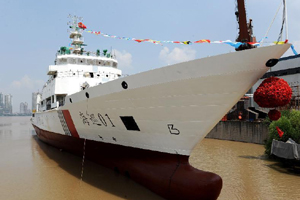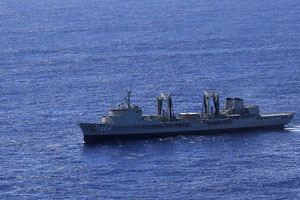| Latest News | Search effort | Families' reaction | Timeline | Reporter's log |
| Infographic | Doubts | Airlines' statement | Photos | China's perspective |
 |
|
Angus Houston, head of the Joint Agency Coordination Center (JACC) for the searching of the missing Malaysian flight MH370 speaks during a news conference in Perth, Australia, on April 7, 2014. An Australian vessel searching the missing Malaysian flight 370 has detected electronic pulse signals probably related to the black box in the Indian Ocean during the past 24 hours. However, the unsuccessful effort to reacquire the signal later may suggest the battery may finish in a very short time, according to searching officials and US Navy technicians. [Photo/Xinhua] |
PERTH, Australia - An Australian vessel searching the missing Malaysian flight 370 has detected electronic pulse signals probably related to the black box in the Indian Ocean during the past 24 hours, however the current unsuccessful effort to reacquire the signal later suggests the battery may finish in a very short time, the search official and US Navy technician said on Monday.
Angus Houston, head of the Joint Agency Coordination Center (JACC), described the new leads as "very encouraging and promising," saying it might be "the best information" the international search team has now.
"Two separate signal detections have occurred within the northern part of the defined search area. The first detection was held for approximately 2 hours and 20 minutes. The ship then lost contact before conducting a turn and attempting to reacquire the signal," Houston told a press conference.
"The second detection on the return leg was held for approximately 13 minutes. On this occasion, two distinct pinger returns were audible. Significantly, this would be consistent with transmissions from both the flight data recorder and the cockpit voice recorder," he said.
The MH370 flight bound for Beijing from Kuala Lumpur disappeared on March 8 and more than 20 countries have gathered to work for its fate, but no debris were found yet.
The Australian navy vessel Ocean Shield currently working in the search area was equipped with US made pinger locator and underwater search vehicle, which successfully found the black box of an Air France airplane which crashed into the Atlantic in 2009.
If the signal's location is confirmed, the underwater vehicle called "Bluefin 21" would be deployed into the 4,500-meter deep water for image and possible wreckage, said the chief coordinator.
Regarding to the pulse signal received by a Chinese search vessel which is 300 nautical miles away, Houston said the two signals were "unlikely" the same one because they are too far away from each other.
Houston stressed that the signals have not been confirmed and it doesn't mean the search team has found the plane.
The Ocean Shield is trying to reacquire the signal, he said.
However, according to the search task force commander, Commodore Peter Leavy, pinpointing the origins of the sound would be very slow and challenging since sound waves in the sea could distort by as much as 90 degrees.
The Ocean Shield would continue to search in a square around the 1,800-metre detection zone and try to relocate the signal in next 24 hours, said Leavy, adding it takes about eight hours to complete a single leg.
Meanwhile, a US Navy technician who helps to run the pinger locator and the underwater vehicle, told reporters the exhausting battery of the black box might be a reason why the signal was not stable.
"The battery life is possible the cause that we haven't reacquired the signal, if the pinger no longer transmits, we are not going to hear from the pinger locator," said Captain Mark Matthews.
He said the towed locator can go straight down up to 6,000 meters and if the black box battery dies, then there should be a sight scan sonar search, which has much shorter detection range and much slower process, and the area where the towed pinger locator now would certainly be the high priority area to conduct further search.
When asked by reporters how long would the underwater vehicle take to get image of the signal location when it's dropped into the water, Matthews said a full mission on the equipment is 20 hour long and it would take another two to four hours to download the data.
"So every mission is about a day long, and nothing happens fast in deep oceanic water," said the US navy officer, adding "we should not be too optimistic until we reacquire the signal."
The international search and recovery continues Monday for the Malaysian flight MH370. Up to nine military planes, three civil planes and 14 ships are scheduled to assist in the search operation and the search area is expected to be approximately 234, 000 square km.
Good weather is expected throughout the day with showers in the afternoon although this is not expected to affect the search.
Since the Chinese ship Haixun 01 reported detections of suspicious pulse signals on Friday and Saturday, the British HMS Echo is en route to assist Haixun 01 to confirm whether the signal is related to the missing flight or not.
Speical:Malaysia Airlines Plane "ended" in sea
|
 |
 |
 |
|
|
|
|
|
|
|
|